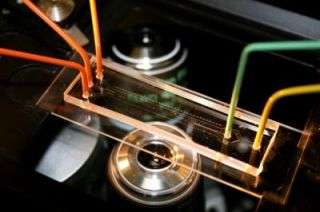Marine bacteria's mealtime dash is a swimming success

Goldfish in an aquarium are able to dash after food flakes at mealtime, reaching them before they sink or are eaten by other fish. Researchers at MIT recently proved that marine bacteria, the smallest creatures in the ocean, behave in a similar fashion at mealtime, using their swimming skills to reach tiny food patches that appear randomly in the ocean blue.
The behavior of bacteria at these small scales could have global implications, possibly even impacting the oceans’ health during climate change.
Scientists in the Department of Civil and Environmental Engineering demonstrated for the first time in lab experiments that the 2-micron-long, rod-shaped marine bacterium P. haloplanktis is able to locate and exploit nutrient patches extremely rapidly, thanks to its keen swimming abilities.
Food sources for these microorganisms come as dissolved nutrients and often appear as localized patches that, if not eaten, are rapidly dissipated by physical processes like diffusion. Foraging, then, becomes a race against time for a bacterium. A rapid response gives it a strong advantage over competitors and may allow it to take up nutrients before they undergo chemical changes. A paper scheduled to publish in the Proceedings of the National Academy of Sciences online Early Edition the week of March 10 describes the research.
“Our experiments have shown that marine bacteria are able to home in very rapidly on short-lived nutrient patches in the ocean,” said Roman Stocker, the Doherty Assistant Professor of Ocean Utilization and lead author on the paper. “This suggests that P. haloplanktis’ performance is finely tuned to the oceanic nutrient landscape. If you are a bacterium, the ocean looks like a desert to you, where food mostly comes in small patches that are rare and ephemeral. When you encounter one, you want to use it rapidly.”
Co-authors on the paper are postdoctoral associate Justin Seymour, graduate student Dana Hunt and Associate Professor Martin Polz all of MIT, and Assistant Professor Azadeh Samadani of Brandeis University.
The researchers were able to prove the behavior of P. haloplanktis by recreating a microcosm of the bacteria’s ocean environment using new technology called microfluidics. Microfluidics consists of patterns of minute channels engraved in a clear rubbery material and sealed with a glass slide. The researchers injected bacteria and nutrients into the microchannels at specific locations and, using video-microscopy, recorded the bacteria as they foraged on two simulated food sources: a lysing algal cell that creates a sudden explosion of dissolved nutrients, and the small nutrient plume trailing behind particles that sink in the ocean.
The question of whether the bacteria could or couldn’t put their swimming skills to use in this race against time has generated considerable interest in the scientific community over the past decade, because there’s a great deal riding on P. haloplanktis’ and their relatives’ ability to reach these nutrients and recycle them for other animals in the food web.
Scientists who study Earth’s carbon cycle know that accounting for all the organic matter in the marine food web is critical, including the matter that exists in these tiny, discrete nutrient patches bacteria feed on. In fact, the carbon in those patches is so important that some scientists believe marine bacteria’s capacity to utilize it will determine whether the oceans become a carbon sink or source during global warming.
Until 25 years ago, scientists weren’t really aware of the microbial loop, the processing of organic material among the smallest creatures in the ocean: bacteria, phytoplankton, nanozooplankton, viruses, etc. Now they know that the roughly 1 million bacteria per milliliter of ocean play a pivotal role in the microbial loop; by recycling that organic matter, they pass it on to larger animals and prevent it from dropping out of the marine food web.
But quantifying the importance of bacteria in the microbial loop has been difficult, because creating a realistic microenvironment wasn’t possible until recently.
“You can hope to study an organism’s behavior only in the context of its environment. The habitat of a bacterium, on the other hand, is extremely small, on the order of microns to millimeters,” said Stocker. “This has made the study of microbial behavior a formidable technical challenge to date. We have been able to create realistic environmental landscapes for studying marine bacteria in the lab by using microfluidic technology.”
P. haloplanktis is a rapid swimmer, propelling itself by a single rotating flagellum in bursts of speed up to 500 body lengths per second. (The fastest land animal, the cheetah, travels at bursts of speed up to 30 body lengths per second.) During experiments, Stocker and team observed that the bacteria used their rapid motility to very effectively swim toward and follow their food sources. That directed movement in response to a chemical gradient (in this case, nutrients) is known as chemotaxis.
“It will be important to see how widespread the use of rapid chemotaxis is in the ocean,” said Stocker. “We expect this to depend on the environment; in algal blooms, for example, nutrient patches and plumes will be abundant, and speedy bacteria will be favored. Whenever this is the case, nutrients get recycled much more rapidly, making the food web more productive and potentially affecting the rates at which carbon is cycled in the ocean.”
Source: Massachusetts Institute of Technology



















